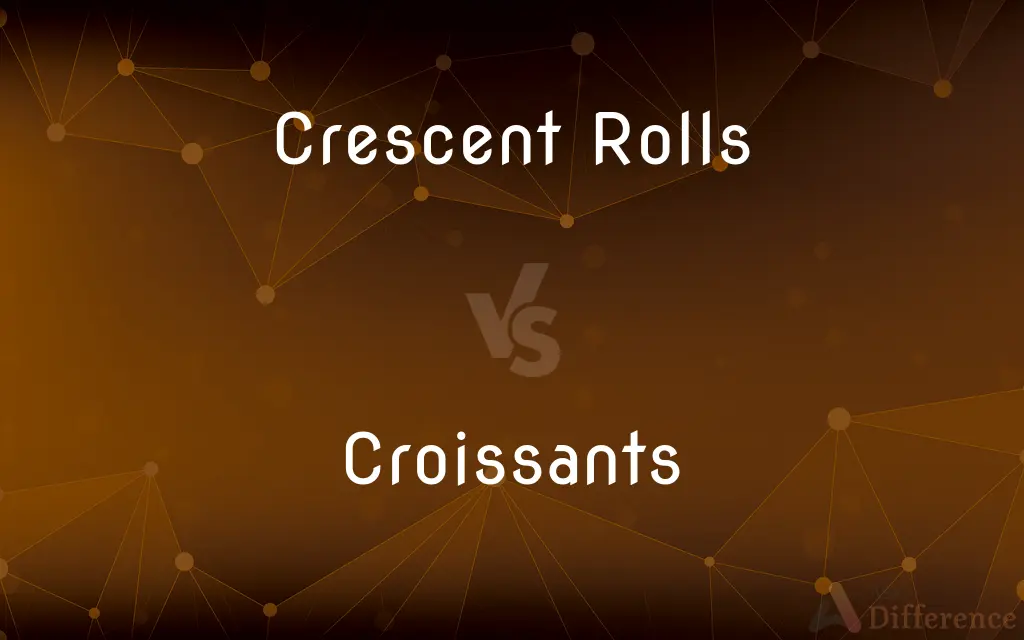Crescent Rolls vs. Croissants — What's the Difference?
Edited by Tayyaba Rehman — By Fiza Rafique — Published on November 23, 2023
Crescent rolls are soft, pre-packaged dough typically used for quick baking, while croissants are a flaky, buttery French pastry made through a meticulous layering process.

Difference Between Crescent Rolls and Croissants
Table of Contents
ADVERTISEMENT
Key Differences
Crescent rolls and croissants, while they may appear similar in shape, have distinctive culinary backgrounds and characteristics. Crescent rolls, a staple in many American households, are usually pre-packaged, ready-to-bake doughs that produce soft, slightly buttery rolls. They are versatile and can be filled with a range of ingredients or served as accompaniments to meals.
Croissants, on the other hand, trace their roots back to France and are renowned for their rich, flaky layers resulting from an intricate process of layering and folding butter into the dough. This method, called "laminating", is key to achieving a croissant's signature layers. The taste and texture of a croissant are unmistakably different from that of a crescent roll, with the former having a delicate crust and buttery interior.
In terms of ingredients, crescent rolls usually have a more straightforward composition, often including flour, water, yeast, sugar, and some fats. Croissants require a similar foundational ingredient list but stand out due to the extensive amount of butter used in their preparation. This butter not only adds flavor but also contributes to the pastry's layered texture.
It's also worth noting that while both crescent rolls and croissants can be shaped into a crescent form, not all croissants are shaped this way. Some are straight, especially in certain parts of France. In contrast, crescent rolls are almost always shaped like a crescent, echoing their name.
Comparison Chart
Origin
American convenience product
Traditional French pastry
ADVERTISEMENT
Texture
Soft and slightly buttery
Flaky, layered, and buttery
Preparation
Pre-packaged, ready-to-bake
Laminated dough with extensive layering and folding
Typical Ingredients
Flour, water, yeast, sugar, fats
Flour, water, yeast, sugar, and a significant amount of butter
Shape
Almost always crescent-shaped
Can be crescent-shaped or straight
Compare with Definitions
Crescent Rolls
Slightly buttery rolls, often used as side dishes.
The soup paired wonderfully with the warm crescent rolls.
Croissants
Pastries that can be straight or crescent-shaped.
In some regions of France, straight croissants are more common.
Crescent Rolls
Pre-packaged dough, ideal for quick meals.
For a quick breakfast, she wrapped sausages in crescent rolls and baked them.
Croissants
Traditional French pastry known for its flaky layers.
Every morning, he enjoyed croissants with his coffee.
Crescent Rolls
Versatile rolls often filled or topped with various ingredients.
I love adding cheese and garlic to my crescent rolls for extra flavor.
Croissants
A symbol of French culinary artistry.
While in Paris, sampling croissants from different bakeries was a must.
Crescent Rolls
Soft, ready-to-bake American dough.
She quickly baked some crescent rolls to accompany dinner.
Croissants
Delicate pastries, often filled with chocolate or almond paste.
Chocolate-filled croissants are my favorite indulgence.
Crescent Rolls
Dough typically shaped like a crescent moon.
The crescent rolls, with their moon-like shape, looked appetizing on the plate.
Croissants
Butter-rich pastries made from laminated dough.
The layers in these croissants are a testament to the baker's skill.
Croissants
A rich, crescent-shaped roll of leavened dough or puff pastry.
Croissants
Plural of croissant
Common Curiosities
Are crescent rolls the same as croissants?
No, crescent rolls are softer and pre-packaged, while croissants are flaky French pastries.
Can I fill crescent rolls with sweet fillings?
Yes, they are versatile and can be filled with both sweet and savory ingredients.
Why are croissants so buttery?
The laminating process involves folding large amounts of butter into the dough.
Can I use crescent roll dough to make croissants?
While similar in shape, the texture and taste will differ from traditional croissants.
Can I buy pre-packaged croissant dough like crescent rolls?
Some stores offer ready-to-bake croissant dough, but it might not match the quality of bakery-made.
Are all croissants crescent-shaped?
No, they can also be straight, especially in certain parts of France.
Are crescent rolls healthier than croissants?
Both are indulgent, but croissants typically have more butter.
What's the key to a croissant's flaky layers?
The lamination process, involving repeated folding and rolling, creates the layers.
How long does it take to make croissants from scratch?
Making croissants can be a day-long process due to resting and laminating steps.
Do croissants originate from France?
While popularized in France, croissants have roots in Austrian "kipferl" pastries.
Can crescent rolls be made without yeast?
Traditional recipes use yeast, but some versions use baking powder as a leavening agent.
Are crescent rolls always baked in a crescent shape?
Mostly, yes, reflecting their name. However, they can be shaped differently based on preference.
Is it challenging to make croissants at home?
While time-consuming, with patience and practice, homemade croissants are achievable.
Why are my croissants not flaky?
Achieving flakiness requires precise butter layering and dough handling.
Can I add toppings to crescent rolls before baking?
Absolutely, popular toppings include seeds, cheese, or garlic butter.
Share Your Discovery

Previous Comparison
Curling Iron vs. Straightening Iron
Next Comparison
Have To vs. Want ToAuthor Spotlight
Written by
Fiza RafiqueFiza Rafique is a skilled content writer at AskDifference.com, where she meticulously refines and enhances written pieces. Drawing from her vast editorial expertise, Fiza ensures clarity, accuracy, and precision in every article. Passionate about language, she continually seeks to elevate the quality of content for readers worldwide.
Edited by
Tayyaba RehmanTayyaba Rehman is a distinguished writer, currently serving as a primary contributor to askdifference.com. As a researcher in semantics and etymology, Tayyaba's passion for the complexity of languages and their distinctions has found a perfect home on the platform. Tayyaba delves into the intricacies of language, distinguishing between commonly confused words and phrases, thereby providing clarity for readers worldwide.












































